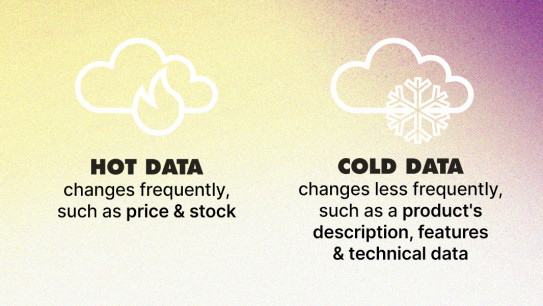
Get the best out of PIM: lay the groundwork
Setting up a PIM (Product Information Management) system is a massive task that must be scoped out from the start in order to get the most out of this powerful tool. Learn how to set up the necessary conditions for it to run smoothly and be used correctly by internal teams.
Data: the sinews of PIM
PIM's major goal is to use and communicate relevant and appropriate data to the proper channels. Preparatory work focuses on supplying high-quality data, identifying data sources, and specifying data flows among the IS's many components.
Your PIM system will be completely useless if data is not upgraded, qualified, and cleaned, or if it is inadequate, incomplete, inappropriate, and contains errors. The customer experience will be the first to suffer. Customers will quickly switch to another brand to place their order if photographs and details do not match the proper product, if an incorrect stock display prohibits them from completing a purchase, or if they are unable to find the exact technical features they are looking for! A PIM solution immediately contributes to the product experience, aids in purchasing decisions, and influences conversion rates. Therefore it is closely linked to company performance.
A work session should be conducted in the early stages to prepare data that will be fed into the PIM solution.

Data content
Above all, quality data must be delivered to a PIM system. So, what do we mean when we say "quality data"? First and foremost, it must exist! We frequently discover that we lack the needed information for 50% of products, or that the information is incoherent. Has data been enriched if it exists? The level of detail in the product is determined by the amount of data available. There are two sorts of data: dynamic or "hot data," which changes frequently, such as price and stock, and "cold data," which changes less frequently, such as a product's description, features, and technical data. Detailed product presentations soothe potential clients and pique their interest in making a purchase.

It's critical to establish a level of completion: Which attributes must a product possess in order for it to display on the website? What requirements must be met?
PIM contributes to the crucial task of referencing by highlighting the data and characteristics that are most highly valued on Google and other search engines. Distributing rich and relevant data is also helpful for SEO colleagues, because PIM contributes to the crucial task of referencing by highlighting the data and characteristics that are most highly valued on Google and other search engines. It's a good idea to get the help of an SEO company right from the start of your project.
Finally, in order to generate a homogeneous end display, we must consider the data's outer consistency in addition to its quality and richness. Should all product names, for example, be written in capital letters?
Data input and output
We're searching for high-quality data, both in terms of content and format. We must, however, be able to locate it. A second stage entails identifying data sources so that we know where to look for it. There is often a lot of mixed-quality data spread throughout the ERP system in older information systems. Some data is special to retail, while others are specific to e-commerce, with each distribution channel having unique requirements and obtaining data from various sources.
A PIM solution is a new module that can be added into an existing IT environment to convey pertinent data to associated apps automatically. Its integration is more of a technological issue, but one that has a direct bearing on data. How do inputs go into the PIM system, and whose information system modules do they come from? How does data exit the system, and what connections must be built in order to export it to the channels?
We create a data model to represent the types of data that will be retrieved for a certain product family, as well as the sources and destinations of that data. This model depicts all of the data as well as the different flows that transport it from its source to its final destination.
There's also the issue of distribution, which must be considered in order to make effective use of data. Depending on the destination, information is delivered in a particular way in terms of substance and manner. While it is preferable to be pretty succinct in terms of content offered for mobile applications, significantly more detail is required for an e-commerce website. Photographs are required for a print catalogue, but descriptions should be minimal.
PIM's sinews are data, but it's a tool that can't live on its own! A PIM solution will not get very far without the right people to feed it and run it. Who will look after it once it's been set up, and how will they do so? The second requirement is to define how teams will collaborate from the start of the project.
PIM: at the crossroad of business teams
A PIM solution is a repository for data, including technical, marketing, and legal information. These many forms of information originate from several departments. A PIM solution is a huge organizational challenge because it demands cooperation between such a varied group of people!
Who is going to use the PIM solution? Who will add to it? And when is it going to happen? What kind of data are you working with? The numerous contributors must be mapped out using a data model in order to specify the appropriate user and user group settings, assign the necessary rights, identify approval workflows, and schedule data entry stages according to the PLC (Product Life Cycle). What exactly is the goal? To determine how you will work effectively with the PIM solution while incorporating your unique requirements.
Collaborations between the various divisions must be orchestrated. If individual responsibilities aren't well defined and processes aren't obvious, you'll waste time and have to revert to manual data entry, but a well-designed PIM system has a lot of automation possibilities.


